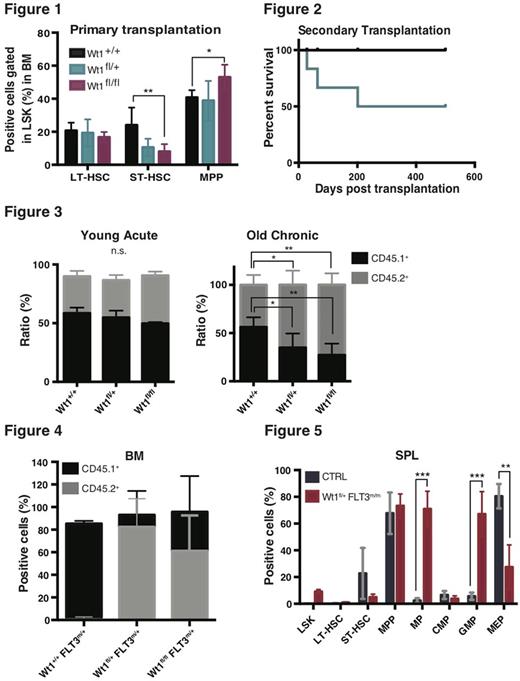Abstract
Genetic studies have identified recurrent somatic mutations in Acute Myeloid Leukemia (AML) patients, including in WT1 (Wilms' tumor gene 1). WT1 encodes for a zinc finger transcription factor that can be either targeted by nonsense/frameshift mutations or, alternatively, overexpressed in AML patients. The molecular mechanisms by which WT1 mutations contribute to leukemogenesis have not been fully elucidated. We recently showed that WT1 acts as a co-factor for TET2-mediated enzymatic function and placement of 5-hydroxymethylcytosine. Here, we show that with time Wt1 haploinsufficiency enhances stem cell self-renewal and cooperates with FLT3-ITD mutations to induce leukemogenesis.
In order to assess the impact of Wt1 loss/haploinsufficiency on hematopoiesis and leukemogenesis in vivo, we generated a hematopoietic-specific conditional Wt1 knockout mice model (Mx1-Cre+ Wt1fl/fl). Studies of steady state hematopoiesis showed that Wt1 loss or haploinsufficiency was not associated with any significant differences in blood parameters compared to control counterparts. Lineage-Sca-1+c-Kit+ from Wt1fl/fl or Wt1fl/+ animals were not able to serially replate in CFU assays compare to control. We did note that homozygous Wt1-deletion induces an increase absolute number of GM colonies. Wt1-deletion led to a reduction in the proportion of ST-HSC percentage and an increase in GMP and MPPs in BM of primary non-competitive transplanted animals (Figure 1). These results showed loss of Wt1 alters myeloid differentiation but does not markedly impact steady state hematopoiesis.
However, when we transplanted Wt1fl/+, but not Wt1fl/fl cells into secondary recipients, we enhanced engraftment of BM cells over control counterparts (Figure 2) and progression to T-ALL. This disease was transplantable and characterized by increased percentages of LT-HSC and MP in the BM of the recipient mice. This led us to hypothesize that WT1 haploinsufficiency, could induce age-dependent changes in hematopoietic stem cell function. Consistent with this proposal, a subset of WT1-haploinsufficient primary elderly mice (18-22 months old) developed hepatomegaly due to liver-specific myeloproliferation and extramedullary hematopoiesis. Moreover, we observed that Wt1fl/+, but not Wt1fl/fl cells, from mice 6-8 months after initial deletion showed a competitive advantage in transplantation assays and increased serial replating. By contrast, loss of one copy of Wt1 did not induce these phenotypes in young mice analyzed 4-6 weeks post deletion (Figure 3) or in mice in which we deleted one copy of Wt1 at 6-8 months of age. These data suggest that Wt1 haploinsufficiency can induce a progressive increase in self-renewal consistent with progressive remodeling of the Wt1-mutant clone.
Given this observation, we hypothesized additional genetic events were required to induce leukemogenesis. Activating mutations in the FLT3 (Fms- like tyrosine kinase 3) gene commonly co-occur with WT1 mutations. To assess if these genes cooperate in leukemogenesis, we crossed Wt1fl/fl mice with Flt3-ITD knock-in mice and induced Wt1-deletion. In vivo competitive assays and serial transplantation experiments showed that Flt3-ITD-Wt1-depleted cells engrafted better in recipient mice than Flt3-ITD cells (Figure 4). Wt1fl/+ FLT3m/m mice developed fully penetrant AML with short latency (5-7 weeks post birth). This disease was characterized by increased percentages of MP and GMP in the BM of these mice compared to controls (Figure 5). Prompted by the known influence of genetic background on the phenotypes resulting from gene-targeting experiments, we bred Wt1fl/+ FLT3m/+ into the mouse strain 129S1/SvImJ. Wt1fl/+ FLT3m/m mouse developed a similar AML with a similar penetrance but a longer latency (7-9 weeks). We also noticed that Wt1fl/+ FLT3m/+ micedeveloped AML in this strain (6-7 months post birth) compare to mice with a C57BL/6 background.
Taken together, our results demonstrate that alterations in WT1 function have a dose- and time-dependent impact on hematopoiesis. We hypothesize that Wt1-haploinsufficiency allows for hematopoietic stem/progenitor cells to accumulate epigenetic changes and secondary mutations (such as FLT3-ITD), which then promote leukemic transformation. This work also demonstrates that AML mutations can induce age-dependent, progressive alterations in hematopoiesis, which contribute to transformation.
Levine: Qiagen: Equity Ownership; Roche: Research Funding; Roche: Research Funding; Celgene: Research Funding; Qiagen: Equity Ownership; Celgene: Research Funding.
Author notes
Asterisk with author names denotes non-ASH members.


This feature is available to Subscribers Only
Sign In or Create an Account Close Modal